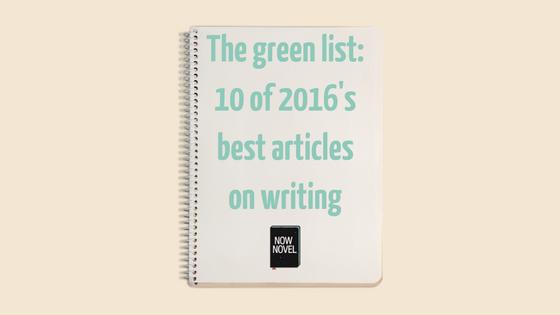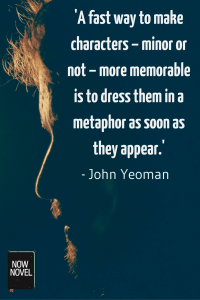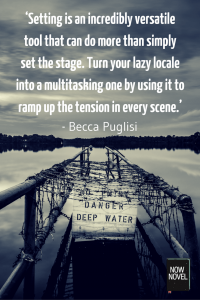Read our list of 10 useful and insightful posts on the craft and psychology of writing from the past year:
1. ‘6 Tips for How to Organize your Novel’s Edits’ – K.M. Weiland
Katie Weiland shares helpful tips for how to edit your novel methodically. Weiland advises to ‘clear out the small stuff first’, proofreading for typos, factual errors and grammar slips. It’s a detailed guide that includes examples of edits for her novel Storming.
Take-home point: Editing your whole manuscript when it’s complete gives you a cohesive view:
‘Whenever I tackle a major edit […] I always read through the entire manuscript. I want to be able to keep the whole story in view, and I want to be sure I’m catching and adjusting all the little tweaks that will ripple throughout the entire story thanks to these new changes.’
2. ‘How to Create Memorable Characters: 8 Little-Known Sleights of Hand’ – John Yeoman
In John Yeoman’s post for Write to Done, he shares excellent advice for creating memorable characters. For example, Yeoman suggests using the ‘Habitus Technique’ – using details of the home or conditions a character dwells in to suggest their nature. A cosy, inviting home can suggest a warm and hospitable character, for example.
Take-home point: Use poetic language such as metaphor and simile to create an indelible character impression:
‘A fast way to make characters – minor or not – more memorable is to dress them in a metaphor as soon as they appear.
‘My first impression of Fergus Lafferty was of a furze bush. Tall, prickly and bent by the wind.’
3. ‘How to Distinguish Yourself Amongst Agents and Editors’ – Jane Friedman
Jane Friedman’s post isn’t specifically about the craft of writing, but it shares a simple and valuable tip for engaging with publishers and agents successfully. Friedman writes about the importance of reading widely in your genre. Understanding current trends in your genre and shared terminology will enable you to speak agents’ and publishers’ language.
Says Friedman:
‘Reading and knowing about other authors or trends in your community gives you awareness of how your work fits into the landscape. It also helps you avoid using the same, possibly boring tropes the agent/editor has seen before.’
Take-home point: Always read broadly in your genre so you understand its trends and tropes and avoid flogging work publishers’ ‘in’ piles are already saturated with.
4. ‘10 Tips for Writing from Multiple POVs’ – Aimie K. Runyan
Aimie K. Runyan’s post on using multiple points of view for the Writers in the Storm blog is packed with practical advice. For example, Runyan advises to balance multiple POV characters’ arcs so that each is developed to a satisfying degree:
‘Each main character deserves a fully fleshed-out storyline, and for this reason, multiple POV books tend to be longer than single narratives.’
Take-home point: Don’t tell a story using multiple points of view simply for the sake of complicating the plot. But you can use multiple points of view to give multiple sides of a group/shared experience.
5. ‘Setting as a Vehicle for Conflict’ – Becca Puglisi
Becca Puglisi’s guest post for Elizabeth Spann Craig’s helpful blog concisely examines how to ratchet up conflict and tension using setting. Puglisi lists potential conflict sources in fictional environments. There can be man-made obstacles (collapsed bridges and locked doors), for example, that impede characters. There are also ‘trigger’ environments that cause characters to recall or revisit difficult experiences.
Take-home point: Instead of simply providing scenery, a setting can actively contribute to the mood and tension of a scene.
‘Setting is an incredibly versatile tool that can do more than simply set the stage. Turn your lazy locale into a multitasking one by using it to ramp up the tension in every scene.’
6. ‘Against Self-criticism […]’ – Maria Popova
Although the language and ideas in this post on Brain Pickings are cerebral and complex, it’s worth reading. Especially if you tend to criticize your own writing to shreds. Maria Popova shares some of the psychoanalytic writer Adam Phillips’ views on the problems of self-criticism.
Excessive self-criticism, states Popova, often reduces complex experiences to single interpretations. For example, we say ‘I’m a bad writer’, rather than being open to alternative ways of framing our situation, such as ‘I am a writer committed to improving my craft’.
Take-home point: Self-criticism serves important functions in moderation.
‘Our self-criticism, to be sure, couldn’t be entirely eradicated — nor should it, for it is our most essential route-recalculating tool for navigating life. But by nurturing our capacity for multiple interpretations, Phillips suggests, self-criticism can become “less jaded and jading, more imaginative and less spiteful.”’
7. ‘How to Take Charge of your Novel’s Symbolism’ – Christine Frazier
Christine Frazier’s Better Novel Project often takes apart bestsellers to show the gears that make them work. In this post on symbolism, Frazier compares details from J.K. Rowling’s Harry Potter series and Suzanne Collins’ The Hunger Games. Frazier shows how symbols mark both authors’ protagonists as chosen. It’s a succinct and insightful post on how you can use symbolism in your fiction to deepen the themes and ideas of your novel.
Take-home point: Symbolism can tie together the narrative threads of your novel and give your readers identifiable details that could become cultural reference points in their own right (e.g. Harry Potter’s bolt-shaped scar).
8. ’25 Reasons Why I Stopped Reading Your Book’ – Chuck Wendig
Chuck Wendig’s brilliant Terrible Minds blog (NSFW for anyone offended by curse words) is always entertaining and engaging. Wendig’s post on reasons why he abandons novels is a good reminder of what not to do. For example, Wendig sums up the pitfalls of being too careful to signal your genre to readers:
‘[I quit when] the book starts off too, um, genre-shellacked. What I mean is, if it’s sci-fi, it’s loaded for bear with bewildering sciencey stuff, or if it’s fantasy it’s all funky names with magical apostrophes, or if it’s horror it’s more interested in soaking the pages in raw, red gore and horror tropes. Context is king, yet again.’
Take-home point: As E.M. Vorster wrote, ‘only connect.’
‘Everything [should not be] just a series of scenes. Scenes need to connect. They are bound by a throughline […] [Avoid] vignettes and moments and setpieces that have been placed next to each other but given no connection. They are rooms without doors or windows.’
9. ‘How to Subtly Boost you Dialogue’s Power with Body Language’ – Alex Limberg
This is a topic we’ve written about here, but Alex Limberg’s post for Janice Hardy’s Fiction University is a concise and insightful study in using gesture and description to convey the tone of a speaker. Says Limberg:
‘Describing your characters’ body language is great to make your dialogue more interesting and to add a little bit of variation and physicality. At the same time, body expressions make your characters feel like real human beings, driven by their emotions. You are also leaving subtle clues for the attentive reader.’
Take-home point: Show a character’s body language in dialogue or describe a feeling but don’t do both in the same sentence – this distracts from the dialogue itself and feel heavy-handed.
10. ‘How to Be a Writer: 10 Tips from Rebecca Solnit’ – Rebecca Solnit
Rebecca Solnit’s post for Literary Hub offers general advice, some of it commonplace but beautifully put. Solnit advises, for example, to read across historical periods to broaden your palette:
‘Read good writing, and don’t live in the present. Live in the deep past, with the language of the Koran or the Mabinogion or Mother Goose or Dickens or Dickinson or Baldwin or whatever speaks to you deeply.’
Take-home point: ‘It’s all up to you.’
What were some of your favourite articles on writing from the past year? Tell us in the comments.




2 replies on “10 of 2016’s best articles on writing”
Great list, Bridget! Thank you so much for including me. 🙂
It’s a pleasure, thanks for the insightful articles.